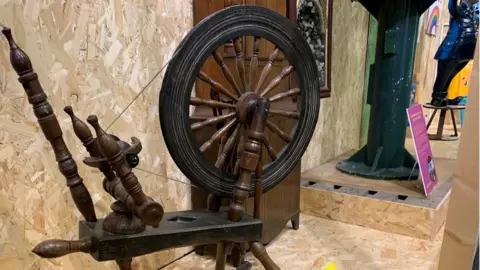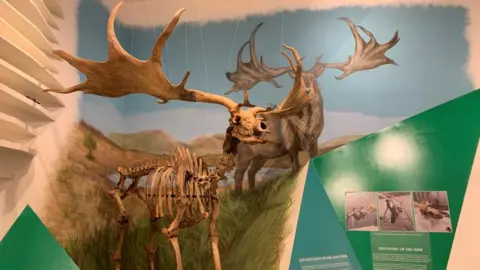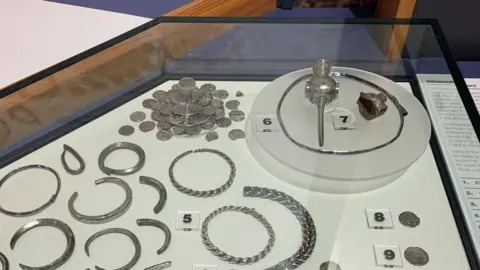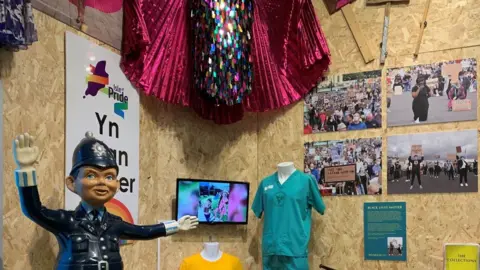Museum reflects on 100 years of Manx history
 MNH
MNHThe Isle of Man's first national museum is marking a century since it opened its doors for the first time.
But unlike other Victorian museums, the Manx Museum did not feature stuffed exotic animals and treasures from far-off lands.
Instead, it showcased Manx history, and the story of the everyday people of the Isle of Man.
Katie King, who curated a new exhibition marking the centenary, said that approach was "ground-breaking".
The museum houses collections featuring natural and social history, archaeology, art, clothing and furniture, as well as the library and archives.
Ms King said, in contrast to its contemporary Victorian museums, which were attempting to "teach world history", the Manx Museum was set up to "educate island people about themselves".

She said: "Other museums were collecting from all over the world and we were just collecting ourselves, which might sound a bit naval gazing, but it wasn't because the world was changing so dramatically."
Although the collections include "really culturally significant objects" like Captain John Quilliam's uniform from the Battle of Trafalgar, everyday objects like spinning wheels, butter bowls and things "that you might keep on your fireplace" were also kept, Ms King said.
"They were collecting ordinary things, and most importantly stories of ordinary people", including songs and recordings of native Manx speakers and Manx dialects, she added.

But the story behind the museum starts before 1922, as the gathering of some of the items featured in the collections goes back as far as 1879.
That was when members of the newly-created Isle of Man Natural History and Antiquarian Society began the process of saving cultural assets "in earnest", Ms King said.
Seven years later, under an Act of Tynwald, the Manx Museum and Ancient Monument Trustees were established to formally collect and preserve the history of the Manx people and the island itself, and come up with the concept of a national museum and funding for it.
Ms King said that step was taken because it had been recognised that the "material culture" of the Isle of Man was "vulnerable" to being placed in foreign museums, sold to private collectors, or destroyed.
But a decade on, with no progress made, frustrations began to arise among those who could see that cultural assets continued to be taken away from the island or treated with disregard.
 MNH
MNHThe discovery of Viking silver during building works in Douglas in 1894, part of which ended up being dumped at a tip, fuelled the frustration of one man in particular, Victorian scholar Philip Moore Callow Kermode.
Unbeknownst to those who found it, the Ballaquayle hoard was the largest single collection of Viking silver ever found on the Isle of Man.
PMC Kermode, who led the antiquarians, was shown one of the coins and identified it as potential treasure trove, leading to a call from the chief constable for it to be recovered and handed in.
The hoard was confirmed as Viking silver by the British Museum in London but was retained by the institution for safekeeping, as the island did not yet have its own museum.

Ms King said PMC Kermode's anger at that loss and the attitudes of people to their own heritage, coupled with the discovery of the skeleton of a giant deer near St John's 1897, acted as the "catalyst" for a renewed drive for a Manx national museum.
The skeleton was one of only two of its kind to be uncovered on the Isle of Man, the first having been claimed by the Duke of Atholl in 1819 and removed to Scotland.
The finds also spurred the island's Lieutenant Governor John Henniker to step in, and in 1905 he allowed Castle Rushen to be used as a temporary home for the growing collections.
But it was in 1921 that a deal was struck between the government and the Henry Bloom Noble Charitable Trustees for the former Noble's Hospital building in Douglas to gifted as a permanent site.
PMC Kermode was appointed its curator and put in charge of transforming the building, which had closed as a hospital in 1912.

The Manx Museum opened its door to the public on 2 November 1922, with the very first object on the museum's register being a silver coin from Ballaquayle hoard, part of which had been returned to the island in advance of the opening.
While the building itself has seen many developments and the way objects are made accessible changed to keep pace with modern wants over the intervening 10 decades, the ethos of the museum remains unchanged, Ms King said.
"The way we're trying to convey that the objects belong to the people of the Isle of Man and these are your stories is probably the same message that PMC Kermode wanted to say," she said.
"It's the same message, come and enjoy and celebrate your story, whether you've lived here one week or 100 years, it's your story."

Why not follow BBC Isle of Man on Facebook and Twitter? You can also send story ideas to [email protected]
